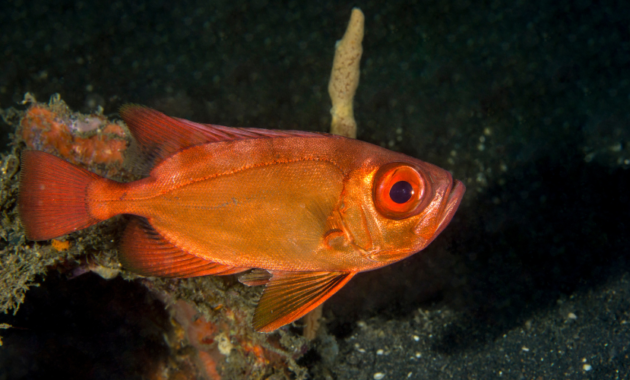
The best 11 unique fish with big eyes are the flashlight fish, fangtooth, telescopefish, barreleye, glasshead barreleye, stargazer, dragonfish, glass squid, spookfish, popeyed goldfish, and tubular fish. In the depths of the ocean, a mysterious world exists.
Here, peculiar creatures with extraordinary characteristics and features roam freely. Among these remarkable beings, some fish stand out for their large, captivating eyes. These mesmerizing eyes not only provide them with enhanced vision in the darkness but also make them appear unique.
We will explore eleven such Fish with big eyes and discover their fascinating adaptations and habits. From the eerie flashlight fish to the fearsome fangtooth, each species in this list promises a remarkable insight into the hidden wonders of the underwater realm. Let’s dive in and uncover the mysteries of these incredible creatures.
- The Giant Ocean Sunfish (Mola mola)
- The Dragonfish (stomias Boa Boa)
- The Telescope fish (gigantura Chuni)
- The Glass head Barreleye (macropinna Microstoma)
- The Bigeye Thresher Shark (alopias Superciliosus)
- The Four-eyed Fish (anableps Anableps)
- The Indian Needlefish (strongylura Anastomella)
- The Barreleye Fish (rhynchohyalus Natalensis)
- The Bigmouth Sleeper (Common bully)
- The Black Swallower (chiasmodon Niger)
- The Atlantic Wolffish (anarhichas Lupus)
- FAQ
- Conclusion
The Giant Ocean Sunfish (Mola mola)
The Giant Ocean Sunfish (Mola mola) is undeniably one of the most fascinating creatures that inhabit the world’s oceans. With its distinct characteristics and unique adaptations for survival, this Fish stands out among all others. In this article, we will delve into the mesmerizing world of the Giant Ocean Sunfish, exploring its physical appearance, one-of-a-kind adaptations, and some interesting facts about this remarkable species.
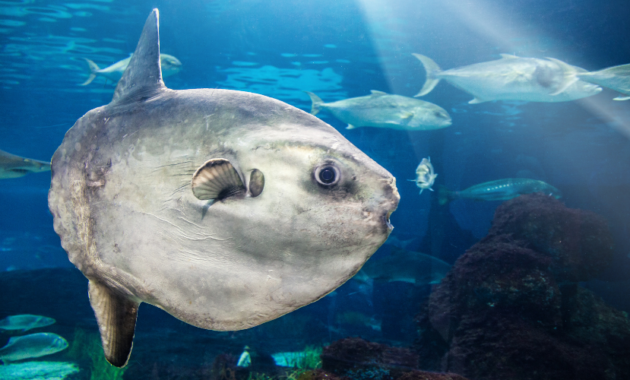
Characteristics And Physical Appearance
The physical appearance of the Giant Ocean Sunfish is genuinely awe-inspiring. These Fish are known for their extraordinary size and distinct shape. They are the largest bony Fish in the world, capable of reaching lengths of up to 10 feet and weighing over two tons!
Their most notable feature is their enormous eyes. With a diameter of up to 25 centimetres, these eyes are huge in proportion to their body size, earning them the title of “The Big-Eyed Giants of the Ocean.” These eyes allow them to have a wide field of vision, which is crucial for their survival in the vast ocean.
Additionally, the body of the Giant Ocean Sunfish is flattened and elongated, almost resembling a horizontal oval or swimming head. This unique body shape is adapted for their slow, graceful movements in the water. With an overall greyish-brown colour, they blend perfectly with their environment, making them difficult to spot even for the most attentive predators.
Unique Adaptations For Survival
The Giant Ocean Sunfish has evolved many unique adaptations that contribute to its remarkable survival in the marine ecosystem. One such adaptation is their specific diet. These Fish primarily feed on jellyfish, consuming massive quantities each day. To catch these gelatinous prey, the Sunfish has developed a beak-like mouth and rows of tiny teeth fused, allowing them to crush their slippery meals and avoid being stung by the jellyfish tentacles.
Another extraordinary adaptation of the Giant Ocean Sunfish is its ability to produce large eggs. A female can produce up to 300 million eggs in one breeding season. Such prolific reproduction helps ensure the species’ survival, even though only a tiny fraction of these eggs reach adulthood.
Interesting Facts About The Species
Here are some interesting facts about the Giant Ocean Sunfish:
- Despite their massive size, they primarily feed on tiny organisms like plankton and jellyfish due to their small mouths.
- The Sunfish is often seen basking near the water’s surface, as they can become infested with parasites that seek refuge in their bodies. Birds and cleaner Fish often help remove these parasites.
- Their unique appearance has led to various mythical and folkloric associations in different cultures worldwide.
- These Fish are excellent divers and can reach depths of up to 2,000 feet for food.
- Unlike most Fish, Sunfish lack a swim bladder, so they are often seen floating near the surface.
- In some regions, Sunfish are considered a delicacy used in traditional cuisines.
The Giant Ocean Sunfish truly represents the wonders of nature and its ability to create extraordinary creatures. With their big eyes, unique adaptations, and intriguing facts, these Fish continue to intrigue and captivate marine enthusiasts and scientists alike.
The Dragonfish (stomias Boa Boa)
The Dragonfish (Stomias boa) is a fascinating species with unique attributes that set it apart from other fishes. As the name suggests, one of its most striking features is its large, luminous eyes, which serve a crucial purpose in its predatory abilities. In this section, we will delve into the overview of the dragonfish species, its distinctive physical attributes, and how its big eyes enhance its hunting capabilities.

Overview Of The Dragonfish Species
The Dragonfish, also known as Stomias boa, belongs to the Stomiidae family, which comprises deep-sea predatory fishes. These species inhabit the dark depths of the oceans, often at depths greater than 1,000 meters. With their long, slender bodies and sharp teeth, Dragonfish are equipped for survival in these extreme environments.
Dragonfish are known for their ability to produce bioluminescent light, making them well-adapted to their deep-sea habitat. They possess light-emitting organs called photophores along their bodies, allowing them to emit a blue-green glow to attract prey or communicate with other Fish.
Distinctive Features And Physical Attributes
Dragonfish have distinctive features and physical attributes that make them truly remarkable. Let’s explore some of these characteristics:
- Slender Body: Dragonfish have long, slim bodies perfectly shaped for swift movements through the water. Their streamlined form allows them to navigate the depths with ease.
- Fang-Like Teeth: With their sharp, fang-like teeth, Dragonfish are formidable predators. These teeth are specially designed for capturing and gripping prey, ensuring a successful strike.
- Bioluminescent Organs: As mentioned earlier, Dragonfish possess photophores along their bodies that emit bioluminescent light. This unique adaptation enables them to blend in with their surroundings and attract unsuspecting prey.
- Long, Extendable Jaws: Dragonfish have an intriguing feature where their jaws can extend beyond their mouths. This allows them to engulf prey larger than themselves, ensuring a substantial meal.
How The Big Eyes Enhance Its Predatory Abilities
The Dragonfish’s big eyes are crucial in enhancing its predatory abilities. Here’s why:
- Enhanced Vision: The large eyes of the Dragonfish enable it to have excellent vision in low-light conditions, typical of the deep-sea environment. This visual advantage helps it spot prey from afar and accurately assess its surroundings.
- Increased Light Capture: The more significant surface area of the Dragonfish’s eyes allows it to gather more ambient light, further improving its vision in the dark depths. This feature enables it to detect even the faintest movements of potential prey.
- Predator Avoidance: The luminous eyes of the Dragonfish serve a dual purpose. While they aid in hunting, they also serve as a means of counterillumination, allowing the Fish to hide their silhouettes and avoid detection by predators lurking below.
In conclusion, the Dragonfish (Stomias boa) is a remarkable species with unique attributes that make it stand out in the deep-sea realm. Its big eyes, in particular, play a vital role in enhancing its predatory abilities by providing enhanced vision, increased light capture, and predator avoidance. These adaptations make the Dragonfish a master hunter in the dark depths of the ocean.
The Telescope fish (gigantura Chuni)
The Telescope fish (Gigantura chunni) is one of the best 11 unique fish with big, captivating eyes, adding a touch of wonder to any aquarium or underwater adventure. Its impressive eyes make it a fascinating sight for nature enthusiasts and fish lovers.
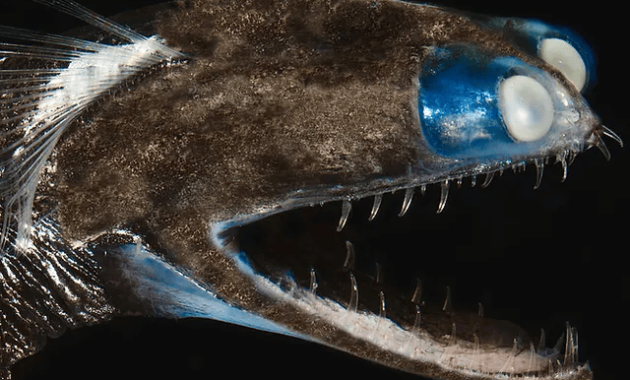
Description Of The Telescope fish (gigantura Chuni)
The Telescopefish (Gigantura chuni) is an intriguing species of Fish known for its distinctive appearance. It belongs to the family of Opisthoproctidae and is widely recognized for its elongated body and, as the name suggests, its huge eyes. This mesmerizing Fish can be found in the deep sea areas of the Atlantic, Pacific, and Indian Oceans, typically at depths of 500 to 2,000 meters.
Explanations On Its Unique Eye Morphology
One of the most striking features of the Telescopefish is its unique eye morphology. The eyes of this species are astonishingly large, which helps them adapt to their dark and dimly lit deep-sea habitat. With their bulging eyes, Telescope fish possess an enhanced ability to capture and process even the faintest traces of light. This eye morphology enables them to detect prey and potential predators in the deep-sea environment efficiently.
Role Of Large Eyes In Its Feeding Behavior
The large eyes of the Telescope fish play a crucial role in its feeding behaviour. The deep-sea environment is characterized by a scarcity of light and low visibility, making it challenging for many species to find food. However, the distinct eye morphology of the Telescopefish gives it a unique advantage.
- The large eyes provide a wider field of vision, allowing the Telescopefish to spot prey over a larger area.
- The remarkable light-gathering ability of their eyes helps them locate bioluminescent organisms, such as tiny shrimp or small Fish, which are abundant in the deep sea.
- Their large eyes also enhance their depth perception, enabling them to accurately judge the distance and position of their prey, making it easier for them to catch their desired targets.
In addition, these exceptional eyesight capabilities aid the Telescope fish in avoiding potential predators and navigating through the darkness of the deep sea.
The Glass head Barreleye (macropinna Microstoma)
The Glass head Barreleye, or Macropinna microstoma, is one of the top 11 unique fish with big eyes. Its transparent head gives it a 360-degree view of its surroundings, making it a fascinating creature in the underwater world.
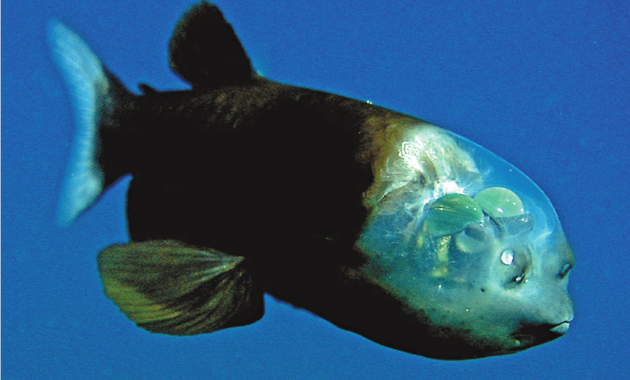
Introduction To The Glass head Barreleye Species
The Glass head Barreleye, scientifically known as Macropinna microstoma, is a mesmerizing fish that inhabits the deep, dark depths of the ocean. It is truly a sight to behold, with its unique physical features and remarkable adaptations for survival. Let’s delve deeper into the intriguing world of the Glass head Barreleye and discover what makes it so unique.
Anatomy Of Its Transparent Head
What sets the Glass head Barreleye apart from other fish species is its transparent head. This extraordinary adaptation allows for unparalleled visibility, especially in the twilight zones of the ocean, where sunlight is scarce. The Fish’s head is dome-shaped and completely see-through, enabling it to see objects above, below, and in front of it simultaneously. How fascinating is that? Inside its transparent head, the Glasshead Barreleye possesses compassionate eyes that can rotate. These eyes are encased in fluid-filled transparent domes that act as protective shields and help maintain the Fish’s unique anatomy. This astounding feature allows the Fish to perceive its surroundings in a 360-degree view, maximizing its chances of spotting prey and avoiding predators.
Advantages Of Having Tubular Eyes That Can Rotate
The tubular eyes of the Glass head Barreleye are another remarkable aspect of its anatomy. Unlike conventional fish eyes, which are spherical, the barreleye’s eyes are elongated and positioned in tubular sockets. This arrangement grants the Fish several advantages in its deep-sea habitat:
1. Enhanced Depth Perception: The elongated shape of the eyes enables the Glasshead Barreleye to gauge distances and perceive the depth of its surroundings accurately. This crucial skill aids in navigating the complex vertical space of the ocean’s depths.
2. Increased Light Capture: The transparent domes surrounding the Fish’s eyes enable more light to enter them, maximizing its ability to detect even the faintest glimmers in the dark depths. This adaptation is particularly beneficial in hunting for bioluminescent prey, which emits light in the deep sea.
3. Wide Field of Vision: The rotating ability of the Glasshead Barreleye’s eyes allows for a wide field of vision. By pointing its eyes in different directions, the Fish ensures it doesn’t miss any potential threats or food sources in the surrounding environment.
4. Stealthy Hunting: The barreleye’s tubular eyes can be directed upward while it faces downward. This arrangement gives the Fish the advantage of stealthily and inconspicuously observing potential prey without alerting them to its presence.
The Glasshead Barreleye is a true marvel of nature, exhibiting extraordinary adaptations that enable it to thrive in the ocean’s depths. Its transparent head and rotating tubular eyes are a testament to the wonders of evolution and the incredible diversity of life beneath the waves. Keep exploring to discover more fascinating creatures that call the mysterious ocean depths their home.
The Bigeye Thresher Shark (alopias Superciliosus)
The Bigeye Thresher Shark, scientifically known as Alopias superciliosus, is a fascinating shark species with large, striking eyes. These sharks belong to the Alopiidae family and are commonly found in the tropical and temperate waters of the world’s oceans.
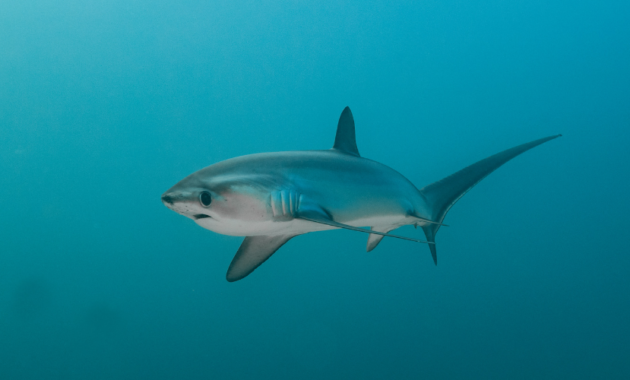
Overview Of The Bigeye Thresher Shark
The Bigeye Thresher Shark is easily identifiable by its unique features, including its large, round eyes, long tail, and slender body. As the name suggests, it possesses enormous eyes, which are proportionally big compared to its body size and play a vital role in its survival and hunting strategies.
Characteristics And Hunting Behavior
In addition to its big eyes, the Bigeye Thresher Shark possesses some other striking characteristics. Their bodies can grow up to 13 feet long, with the tail accounting for more than half their total length. This long, whip-like tail allows them to move swiftly through the water and stun their prey.
The hunting behaviour of the Bigeye Thresher Shark is genuinely remarkable. They are known for using their long, scythe-like tail to herd and stun their prey, such as small Fish and squid. Once the game has been immobilized, the shark uses its mouth full of sharp teeth to consume the captured meal swiftly. This hunting technique is efficient and effective, allowing the shark to feed on various prey.
Role Of Big Eyes In Low-light Environments
The big eyes of the Bigeye Thresher Sharks serve a specific purpose in their natural habitat. As these sharks predominantly inhabit deeper waters, which are often characterized by low levels of light, their large eyes maximize their visual acuity. This enlarged eye size allows for improved light-gathering capabilities, allowing the shark to locate prey and navigate effectively even in dimly lit surroundings.
The adaptation of big eyes in the Bigeye Thresher Shark is crucial for their survival in low-light environments. It enables them to excel as voracious predators by offering a competitive advantage over their prey, granting them heightened visual capabilities to locate and capture food sources successfully.
In conclusion, the Bigeye Thresher Shark, Alopias superciliosus, is a remarkable shark species recognized for its large, prominent eyes. These big eyes not only contribute to their distinctive appearance but also play a vital role in their hunting success in low-light environments. Their fascinating characteristics and hunting behaviour make them a unique addition to the diverse underwater world.
The Four-eyed Fish (anableps Anableps)
Regarding unique Fish with mesmerizing eyes, the Four-Eyed Fish (Anableps anableps) tops the list. This fascinating aquatic creature gets its name from its distinct physical feature that sets it apart from other fish species – a set of divided eyes that allow it to see both above and below the water’s surface simultaneously. In this article, we will dive deep into the description, adaptations, and the role these unique eyes play in the survival of the Four-Eyed Fish.
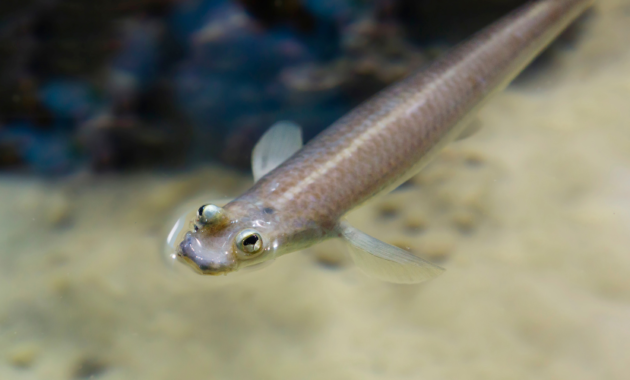
Description Of The Four-eyed Fish
The Four-Eyed Fish, scientifically known as Anableps anableps, is a small to medium-sized Fish that can reach a maximum length of around 30 centimetres. It is native to the freshwater habitats of Central and South America, particularly the rivers and lakes of Guyana and Venezuela. One of the most striking features of this species is its eyes, which are divided into two parts by a band of tissue called a “horizontal streak.”
Each eye of the Four-Eyed Fish has two distinct parts – an upper part and a lower part, which allows it to see both above and below the water’s surface simultaneously. The upper section of the eye is adapted for vision in air, while the lower area is specialized for underwater vision. This unique adaptation enables the Fish to spend most of its time near the water’s surface, feeding on insects and other small creatures.
Adaptations Of Its Unique Divided Eyes
The divided eyes of the Four-Eyed Fish are a remarkable adaptation that allows it to hunt for prey and avoid predators in a dual environment. This species has evolved horizontally elongated eye lenses, which help correct refraction between the air and water interfaces. The eyes also possess a higher number of rod cells, which enhance their low-light vision.
Additionally, the Four-Eyed Fish has a unique arrangement of muscles around its eyes, allowing it to rotate each eye independently. This ability enables the Fish to scan the water’s surface for potential prey while keeping a watchful eye out for predators lurking beneath. It is this remarkable adaptation of having eyes that can operate in two different media that sets the Four-Eyed Fish apart from other fish species.
How The Eyes Help In Tracking Prey And Avoiding Predators
The Four-Eyed Fish’s unique divided eyes are crucial for survival in its freshwater habitat. These eyes allow it to simultaneously track prey on the water’s surface, such as insects and other tiny organisms, while also keeping an eye out for predators below. By being able to spot both potential prey and threats at the same time, the Four-Eyed Fish gains a significant advantage in its quest for survival.
Moreover, the ability to rotate each eye independently gives the Fish a panoramic view of its surroundings, significantly improving its chances of detecting predators. By being alert and responsive to environmental changes, the Four-Eyed Fish can swiftly evade threats and ensure its survival.
In conclusion, the Four-Eyed Fish is a genuinely remarkable aquatic creature with its unique divided eyes. These eyes, adapted for vision above and below the water’s surface, provide the Fish with a distinct advantage in hunting prey and evading predators. As we explore the world of unique Fish with captivating eyes, the Four-Eyed Fish remains a fascinating example of nature’s ingenuity and adaptability.
The Indian Needlefish (strongylura Anastomella)
The Indian Needlefish, known for its big eyes, is one of the 11 unique fish species that stand out. With its distinctive appearance, this Fish captivates the attention of aquatic enthusiasts.
The Indian Needlefish (Strongylura anastomella) is a fascinating species of Fish known for its unique physical characteristics, particularly its large eyes. This slender and elongated Fish is commonly found in the coastal waters of the Indian Ocean, from the Red Sea to the waters of Southeast Asia. Its secretive nature and remarkable hunting abilities make it a subject of great interest among marine enthusiasts and researchers alike.

Notable Features Of Its Large Eyes
The Indian Needlefish stands out due to its extraordinary ocular features, characterized by its disproportionately large eyes. These large eyes serve multiple essential functions in the Fish’s life, including improved visual perception and hunting tactics. The average size of the Indian Needlefish’s eyes allows it to see with incredible precision, even in dimly lit underwater environments. The eyes are positioned towards the front of the head, providing each look with a broad vision, enabling the Fish to detect prey or potential predators from various angles.
Relationship Between Big Eyes And Hunting Strategy
The Indian Needlefish’s big eyes play a significant role in its unique hunting strategy. This species primarily feeds on smaller Fish and crustaceans, and its large eyes give it a distinct advantage in locating and capturing its prey efficiently. With its keen visual perception, the Indian Needlefish can spot the slightest movements or disturbances in the water, enabling it to react swiftly and strike its prey with precision. The prominent eyes act as excellent tools for target fixation, allowing the Fish to focus on a specific point before launching its attack.
The combination of its elongated body, streamlined shape, and large eyes allows the Indian Needlefish to swiftly move through the water, propelling itself towards its unsuspecting prey. This unique hunting strategy, enhanced by its remarkable visual abilities, ensures the Indian Needlefish has a higher rate of successful hunts than other species with less developed eyesight.
The Barreleye Fish (rhynchohyalus Natalensis)
When it comes to unique underwater creatures, the barreleye fish is undoubtedly hard to miss. Known scientifically as Rhynchohyalus natalensis, this extraordinary Fish possesses an eye-catching feature that sets it apart from other aquatic species. Its mesmerizing eyes, situated on top of its transparent head, make the barreleye fish a captivating subject of study for marine biologists and enthusiasts alike.
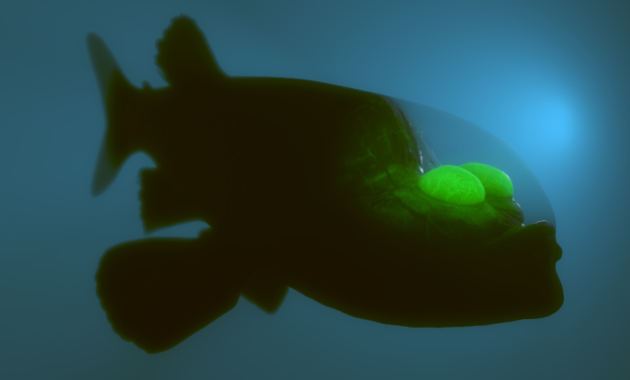
Overview Of The Barreleye Fish Species
The barreleye fish, also referred to as the spookfish or the Macropinna microstoma, is a deep-sea dweller that can be found in various parts of the world’s oceans, especially in the Pacific, Atlantic, and Indian Oceans. Despite being relatively small, with an average length of around 15 centimetres, this Fish showcases exceptional adaptability to its dark and cold habitat.
Its unique features, including a transparent head and barrel-shaped body, aid the barreleye fish in surviving at depths of up to 800 meters below the surface. Despite its eerie appearance, this remarkable Fish is a fascinating subject for scientists and nature enthusiasts, as it continues to reveal surprising discoveries about its anatomy and behaviour.
Unique Head Structure And Transparent Dome
One of the most striking features of the barreleye fish is its transparent dome-shaped head, which allows its specialized eyes to remain above the rest of its body. This fine structure is made up of gelatinous tissue, providing the Fish with the ability to observe its surroundings in a truly remarkable way.
Notably, the transparent dome also acts as a protective shield for the barreleye fish. It shields the delicate eyes from potential harm, such as abrasive debris or prey struggling to escape. This structural adaptation ensures that the eyes remain unharmed, allowing the Fish to navigate its dark environment effectively.
Function Of Its Upward-facing Eyes
What truly sets the barreleye fish apart is the positioning of its eyes. Unlike most fish species, its eyes face upwards rather than laterally. This extraordinary adaptation allows the barreleye fish to spot prey or predators lurking above them, proving advantageous in its deep-sea ecosystem.
The barreleye’s upward-facing eyes also offer a wider field of vision, enabling it to detect faint movements and changes in light, ensuring it doesn’t miss any potential food sources or threats in its environment. This unique ocular configuration showcases the remarkable evolution and adaptation of the barreleye fish to its dark and mysterious underwater habitat.
Overall, the barreleye fish’s distinctive head structure, transparent dome, and upward-facing eyes make it a fascinating specimen worth studying. Its remarkable adaptations provide valuable insights into the fantastic diversity and ability of aquatic life to thrive in even the most extreme environments.
The Bigmouth Sleeper (Common bully)
The Bigmouth Sleeper, scientifically known as Gobiomorphus cotidianus, is one of the most fascinating fish species due to its large and captivating eyes. Native to freshwater lakes and rivers of New Zealand, this unique Fish has attracted the attention of researchers and fish enthusiasts alike. Its distinct physical feature – big eyes, contributes to its intriguing feeding behaviour and ensures its survival in low-light environments. Let’s dive deeper into the description, influence on feeding behaviour, and the role of these large eyes in low-light environments.
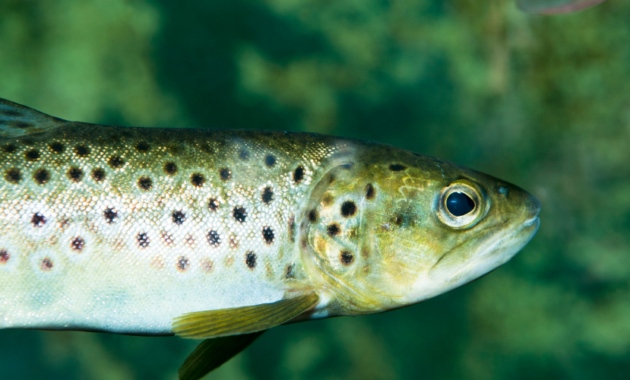
Description Of The Bigmouth Sleeper
The Bigmouth Sleeper is a medium-sized fish species that can grow up to 20 centimetres in length. Its body is elongated, slightly compressed, and has a mottled or dark brown colouration, blending in with its natural habitat. However, what truly sets this creature apart are its vast eyes.
The eyes of the Bigmouth Sleeper display a remarkable characteristic – they are disproportionately large compared to the Fish’s body size. These bulging eyes not only give the Fish a unique appearance but also play a significant role in its feeding behaviour and overall survival.
Influence Of Big Eyes On Its Feeding Behavior
The large eyes of the Bigmouth Sleeper have a direct influence on its feeding behaviour. With enhanced visual capabilities, this Fish can detect and locate prey more efficiently. The big eyes, coupled with its keen sense of vision, allow it to judge the distance and position of its potential meals accurately.
As an opportunistic predator, the Bigmouth Sleeper relies heavily on its ability to spot and ambush unsuspecting prey. Its large eyes grant it a wider field of vision, enabling it to survey its surroundings and identify potential meals, ranging from aquatic insects to smaller Fish.
Role Of Large Eyes In Low-light Environments
One of the standout features of the Bigmouth Sleeper is its adaptation to low-light environments. The large eyes of this Fish provide a clear advantage in dimly lit or murky waters where visibility is limited.
The increased surface area of the eyes allows the Bigmouth Sleeper to gather more light, enhancing its ability to see in conditions where other Fish might struggle. This adaptation gives the species a significant edge, enabling it to hunt and find food even when light levels are low.
By having the advantage of large eyes in low-light environments, the Bigmouth Sleeper showcases its evolutionary adaptations, ensuring its survival and successful navigation in the challenging habitats it inhabits.
The Black Swallower (chiasmodon Niger)
The deep sea is home to some of the most fascinating and bizarre creatures on the planet. Among these is a remarkable fish known as the Black Swallower. Scientifically named Chiasmodon niger, this species is renowned for its unique characteristics and extraordinary set of large eyes.

Introduction To The Black Swallower Species
The Black Swallower, or Chiasmodon niger, is a deep-sea fish that inhabits the ocean depths around the world. With a slender body and an average length of about 9 inches, this species may appear unremarkable. However, its enlarged eyes distinguish it from other Fish, giving it a striking appearance.
Found in the Atlantic, Pacific, and Indian Oceans, the Black Swallower has adapted to survive in the depths where light is scarce. Its dark colouration allows it to blend seamlessly with its surroundings, making it a stealthy predator in the mysterious depths of the ocean.
Feeding Habits And Anatomy Of The Fish
Despite its relatively small size, the Black Swallower has an astonishing ability to consume prey much more significantly than itself. Its feeding habits are truly unique and have fascinated scientists for years. This Fish possesses an extremely stretchy stomach, allowing it to swallow prey up to ten times its size.
The anatomy of the Black Swallower is designed explicitly for its unusual feeding habits. Its jaws are hinged to provide a wider gape, enabling it to engulf prey in a single, swift motion. Its long and slender body allows it to slither into the mouths of larger Fish or consume organisms whole.
Connection Between Large Eyes And Deep-sea Survival
The significant presence of large eyes in the Black Swallower species is not a mere coincidence. In the ocean’s depths, where sunlight cannot penetrate, prominent eyes are crucial for survival. The Black Swallower relies on its enlarged eyes to detect the faintest traces of bioluminescence, which many deep-sea organisms emit.
With its keen vision, the Black Swallower can locate its prey and navigate through its dark and treacherous habitat. Its large eyes also allow an increased surface area for capturing limited available light, enhancing its ability to see in near-complete darkness.
The Black Swallower’s large eyes, combined with its other unique adaptations, enable it to thrive in an environment that is both bleak and rich in mystery. The ocean depths hold many secrets, and the Black Swallower is a testament to the endless wonders that lie beneath the surface.
The Atlantic Wolffish (anarhichas Lupus)
The Atlantic Wolffish (Anarhichas lupus), also known as the seawolf, is a fascinating creature that inhabits the cold waters of the North Atlantic Ocean. As the common name suggests, it belongs to the wolf fish family and is critically acclaimed for its unique characteristics. One standout feature of this majestic Fish is its big eyes, which play a vital role in its survival in the deep-water habitat.
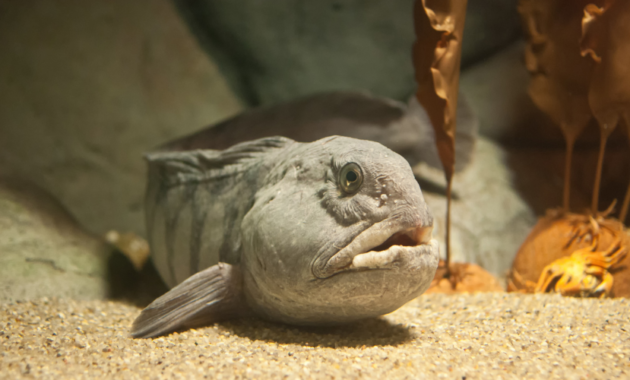
Overview Of The Atlantic Wolffish
The Atlantic Wolffish, scientifically known as Anarhichas lupus, is an enchanting species that inhabits the North Atlantic Ocean. With a length ranging from 3 to 5 feet and weighing up to 40 pounds, the Atlantic Wolffish boasts a stout and elongated body covered in dense, bluish-grey skin. Its snout has sharp teeth perfectly designed for its carnivorous feeding habits. Moreover, the species is predominantly found at depths ranging from 100 to 1,000 meters, making it a mysterious dweller of the deep sea.
Distinctive Features And Hunting Strategies
The Atlantic Wolffish is known for its distinctive features and unique hunting strategies. It has an elongated, eel-like body that enables it to navigate the underwater terrain with agility and precision. This Fish possesses substantial pectoral fins and a powerful tail, which aids in rapid movements and efficient hunting. Furthermore, its sharp and powerful jaws are equipped with powerful teeth, allowing the Atlantic Wolffish to crush the shells of its prey, which primarily consists of crustaceans, molluscs, and other fish species.
To secure its meals, the Atlantic Wolffish employs clever hunting strategies. Utilizing its strong jaws and sharp teeth, this Fish can ambush its prey from hidden crevices or cracks in the ocean floor. By staying hidden and motionless, it ensures its game only senses its presence once it is too late. This stealthy and patient approach, combined with its swift movements, gives the Atlantic Wolffish an upper hand in capturing its meals with ease.
Significance Of Big Eyes In Its Deep-water Habitat
The Atlantic Wolffish’s big eyes hold great significance in its deep-water habitat. In the dimly lit depths where the sunlight barely reaches, visibility is significantly reduced. To compensate for the lack of light, this Fish has evolved with large eyes with enhanced light-gathering capabilities. These big eyes allow the Atlantic Wolffish to detect and locate prey in the darkness, providing a crucial advantage for its survival.
Moreover, the Atlantic Wolffish’s big eyes aid in communicating and perceiving within its species. Through visual cues, these Fish can establish territories, court potential mates, and effectively communicate and interact with other individuals in their environment. The large size of their eyes also contributes to their overall appearance, giving them an intimidating and captivating look.
In conclusion, the Atlantic Wolffish, with its distinctive features and big eyes, is truly an extraordinary creature of the deep. Its unique hunting strategies, coupled with its ability to adapt to the challenges of its deep-water habitat, make it a remarkable species worthy of admiration.
FAQ
What Fish Has The Big Eyes?
The deep-sea Dragonfish is known for its big eyes, which help it see in the ocean’s darkness.
What Is The Fancy Fish With Big Eyes?
The fancy Fish with big eyes is the telescope goldfish. It has distinctive eyes that protrude from its head.
What Fish Has Interesting Eyes?
The Fish with attractive eyes is the deep-sea barreleye. Its eyes are transparent and can rotate to see in different directions.
What Kind Of Fish Has Big Black Eyes?
The kind of Fish with big black eyes is the black drum. It has distinctive black eyes that stand out.
Conclusion
To sum up, these 11 unique fish with big eyes are a fascinating sight to behold. From the eerie deep-sea creatures to the exotic tropical marvels, each species brings beauty and mystery to the underwater world. With their captivating gaze and distinctive features, these Fish remind us of the incredible diversity and wonder of nature.
So, next time you’re diving or exploring an aquarium, keep an eye out for these extraordinary Fish with their mesmerizing big eyes.
